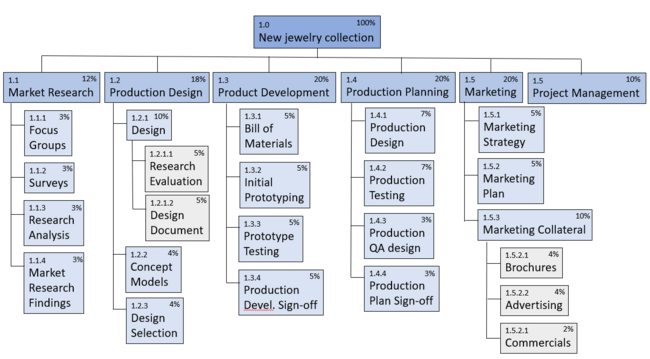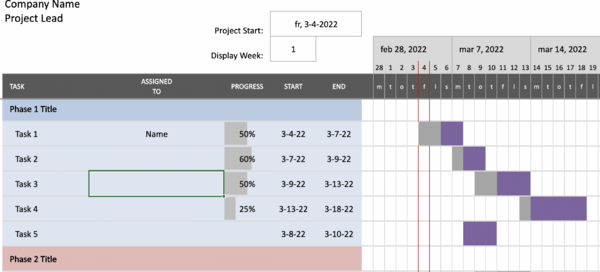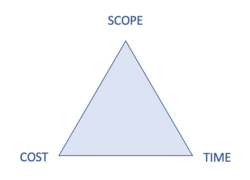Project success vs Project management success
(→Project success) |
(→Project success) |
||
| Line 138: | Line 138: | ||
| − | + | Figure 4 shows the three dimensions of performance and the measures they encompass | |
=== Overall success === | === Overall success === | ||
Revision as of 12:00, 5 March 2022
Two perspectives need to be considered when evaluating a project’s performance: project success and project management success.
Project success answers the question “Was the right project done”? This relates to the effectiveness of the project, which translates into the long-term benefits and value of the project. Some of the factors that enable project success are the cooperation of both project management and line management and aligning projects with the organization's strategy and goals.
On the other hand, project management success responds to the question “Was the project done right”? This relates to efficiency in the project which translates into delivering the project within the constraints: scope, quality, and time. Some activities that enable project management success are planning and scheduling, cost, and risk management.
Even though one kind of success does not guarantee that the project will be completely successful, several studies have shown a correlation between these two kinds of success. The chances of the overall project's success rise when the right planning, budgeting, and scope are defined in advance. Many frameworks have been developed to measure project success. Some of them focus on overall success, such as "The relative importance of project success dimensions” developed by Stan Lipovetsky. It suggests measuring project success by evaluating four different dimensions: meeting design and planning goals; customer benefits; benefit to the implementing organisation; and benefit to the infrastructure. Alternatively, other frameworks only focus on one kind of success, such as the Iron Triangle of Projects, which involves the three main constraints in Project Management: cost, quality and cost.
One of the main limitations when evaluating project success is that it can be very challenging defining success criteria. As viewpoints and priorities differ, individuals will perceive success differently. Furthermore, effectiveness measures are less tangible and, as they are focused on long-term benefits, they are more difficult to estimate.
Contents |
Big idea
The way in which a project's success is measured has evolved over time. Traditionally, projects were measured using a classic approach. Nowadays, we are moving towards using a state of the art approach [1].
- The classic view focuses on the requirements of the project, short-term output and time, cost and scope.
- The state of the art view evaluates the overall business case, the vision, long-term benefits and the success criteria. This view makes it harder to assess a project's success as it is more vague and harder to quantify.
A common description of a project manager’s goal is to manage projects in such a way that brings completion on time, within budget and that ensures the intended quality [2]. Hence, quality and scope should be defined from the very beginning of the project. Even though the right planning of the project does not guarantee success, the lack of planning will most likely cause it to fail. Therefore, one would assume that defining the right planning, budgeting and scope clear in advance would at least, increase the chances of a project’s success. However, there have been many projects that followed the initial plan, leading to completion within time and budget while meeting previously defined success criteria but ended up failing. These projects failed to provide long-term value for the company or produce any benefits for stakeholders [3]. Therefore, to assess a project’s success, two perspectives have been defined [4]:
- Project success is based on the long-term benefits and value of the project. It is associated with effectiveness, which is the capability of delivering the desired result
- Project management success is based on delivering the requirements on time within budget. It is associated with efficiency, which is doing things right. Successful project management means planning in the right way and following the plan.
Project Management Success
Project management success answers to the question: “Was the project done right?”. A project manager must manage time, cost, and quality. Once the objectives and business case of a project have been clearly defined the project manager and their team should use the available resources to meet the objectives within the constraints. On the other hand, projects are always characterized by a certain level of uncertainty, which will most likely change the course of the project. To minimize risks and their consequences, it is also essential for the project manager to make proper risk management and monitoring plan to make sure that the project is still delivered within the given constraints [5].
The main activities of a project manager to enable project management success are the ones that follow [6]:
- Planning: Defining the project deliverables and requirements and define how the project objectives should be met.
- Benefit Management: Making sure that the customer realizes the benefits described in the business plan.
- Scope Management: Determining and documenting the outputs, outcomes and benefits of a project.
- Resource Management: Plan, allocate and schedule the available resources in the most efficient way
- Schedule Management: Forecasting the start and end date of all activities in a project
- Cost Management: Estimating, budgeting and controlling the costs involved in a project
- Risk Management: Listing and assessing all possible risks for a project, as well as making a mitigation plan to reduce or cancel the effects.
- Issues Management: Resolving issues to make sure there is not a negative impact in the project
- Change Control: Controlling changes and accepting or rejecting them
- Quality Management: Establishing standards for the project as well as the steps to meet them
- Stakeholder Engagement: Understanding, building and maintaining relationships with the stakeholders of the project
- Communication Management: Enabling effective communication with stakeholders to contribute to the project’s goals completion
- Managing organizational and societal change: Ensuring the delivery of desired outcomes under changes in both the organization and society
- Reporting: Presenting the current status of the project to forecast and make educated decisions
- Information and documentation Management: Making sure the necessary information is available for those making decisions
- Procurement: Obtaining the necessary products and services for the project’s completion
- Lessons learned: Documenting and sharing the lessons learned of a project to use in future projects
Project Success
Project success answers to the question: “Was the project right project done?”. Project success occurs when it delivers the benefits that were anticipated by the stakeholders who initiated the project. Usually, this type of success has to do more with "value for money" and it's probably the most valuable to the sponsor. Project success is harder to evaluate than project management success since the benefits of a project are often realized after completion, not during the lifecycle of the project [7]. However, several studies have been made concluding that some of the factors that enable project success are the ones that follow [8]:
- A process for delivering and managing benefits that involves the cooperation of both project management and line management.
- Manage projects according to an organization's strategy and goals by utilizing portfolio and programme management practices.
- Project, program, and portfolio metrics that provide direct feedback on current project performance and future success to make sure that project, portfolio, and corporate decisions are consistent.
- Using implicit and explicit knowledge to achieve continuous improvement in the management of projects. This should encourage project managers to learn and integrate such learning into continuous improvement in practices and processes.
Application
Many different frameworks have been developed throughout the years to help achieve and measure project and project management success. Some of these methods will be presented in this article divided based on wether they are related to project management success, project success or overall success.
Project Management success
Work Breakdown Structure
Developing a Work Breakdown Structure (WBS) is the foundation for initiating, planning, executing, monitoring and controlling a project [9]. A WBS is specially useful for complex projects as it consists in breaking it down into more more manageable individual components in a hierarchical structure. To create the WBS, the project manager and technical team need to define the main project deliverables. Afterwards, the defined deliverables are decomposed into smaller activities. These activities can be decomposed into smaller tasks. The number of times that the activities are broken down depends on each project and project manager. One can set rules for how small the activities should be, for example, all activities need to last less than ten hours. Once the WBS has been defined it is much easier to make cost and time estimates for each individual activity, as well as risk identification [10].
Gantt Chart
A Gantt chart is a project scheduling tool where all the project activities are represented against time. Each activity has a start and end date, as well as duration. All activities are represented in a timeline as horizontal bars. The length of the bars depends on the duration of the activities and the position depends on the start time. In order to be able to build a Gantt chart, all the interdependencies between activities need to be defined to be able to place each activity in the right position in the chart. Gantt charts give an overview on timelines and deadlines of all activities, relationships and dependencies between activities as well as the different project phases. If a Gantt chart is going to be used to monitor the time constraint of a project, it should be developed at the beginning of the project, once all activities have been determined. Once the project has started, the actual progress needs to be compared against the initial plan in the Gantt chart, which can be adjusted throughout the project if needed [11].
Iron Triangle
The Iron Triangle, also sometimes referred to as the Project Management Triangle or the Triple Constraint, is a tool that represents the relationship between the three most basic success criteria and constraints in project management: cost, scope and time. This tool is based on the fact that the three criteria/constraints are interrelated. Fixing or changing one of the constraints the triangle will have an impact on the other two. This means that if, for instance, the budget of the project is reduced, either the time will need to be longer or the scope will need to be narrowed down [12]. In order for a project to be successful from the project management perspective, the project manager needs to find the right balance between the three vertices of the triangle [13].
Project success
The three dimensions of performance by Cooper and Kleinschmidt
Previous studies to this framework had suggested that project success was a simple, one-dimensional concept. Cooper and Kleinschmidt believed otherwise and examined ten independent measures that defined project success. It was concluded that these measures could be simplified and represented as the combination of three different dimensions related to each other: financial performance, opportunity window and market impact. These are called the three dimensions of performance [14].
The ten independent measures to define project success and their definition are shown in Table 1.
| Measure | Definition |
|---|---|
| Profitability Level | The extent to which a product's profitability exceeded expectations compared to the minimum acceptable level of profitability. (Traditional measure of success or failure) |
| Payback Period | Amount of time required for the project's investment to reach the break-even point (It is a negative measure - the higher the value the worse the performance) |
| Relative Sales | Sales of the product in terms of other recent new products introduced by the firm (last 5 years). |
| Relative Profits | Profits of the product in terms of other recent new products introduced by the firm (last 5 years). |
| Sales vs Objectives | Amount of sales (dollars) exceeding or falling short of sales targets. |
| Profit vs objectives | Amount of profit exceeding or falling short of profit targets. |
| Domestic Market Share | Market share in the third year after launch in the domestic market. |
| Foreign Market Share | Market share in the third year after launch in the foreign market. |
| Window on New Product Categories | Whether the product opened up new product categories for the company. |
| Window on New Market | Whether the product opened up a new market for the company. |
Figure 4 shows the three dimensions of performance and the measures they encompass
Overall success
- Pinto and Mantel identified three aspects of project performance as benchmarks for measuring the success or failure of a project: the implementation process, the perceived value of the project, and client satisfaction with the delivered project (https://www.developmentaid.org/api/frontend/cms/file/2020/11/Pinto-The-Causes-of-Project-Failure.pdf)
- Lipovetsky et al. analyzed defense projects, concluded that the success dimensions meeting design goals and benefit to the customer are the most important ones to all stakeholders in the projects (customer, developer or purchasing organization) (https://www.researchgate.net/publication/262836785_The_Relative_Importance_of_Success_Dimensions_in_Defense_Development_Projects)
- The five dimensions of project success
Limitations
(500 words)
- When does it make sense to talk about project management/project success? Fex if a company is not project management driven
- When is only one success enough? Do we always need to have both kinds of success?
- The value of a project and its long term benefits might be very difficult to estimate
//Critically reflect on the tool/concept/theory and its application context. What can it do, what can it not do? Under what circumstances should it be used, and when not? How does it compare to the “status quo” of the standards – is it part of it, or does it extent them? Discuss your article in the context of key readings / resources provided in class. Substantiate your claims with literature
- It is difficult to categorise and reduce the factors that influence project success to a manageable number (https://www.sciencedirect.com/science/article/pii/S0263786313000884?casa_token=MlYJCFmuEi4AAAAA:6_I5JGL1CwuGULRsf__NUskFDcWPCJgIOjsfPjuyPtMyogjibuxE1x45bTMfeD_WNdPtEP6i8rxS#bb0350)
- There is only limited agreement among authors on critical factors and their individual influence on Project Success (https://www.sciencedirect.com/science/article/pii/S0263786313000884?casa_token=MlYJCFmuEi4AAAAA:6_I5JGL1CwuGULRsf__NUskFDcWPCJgIOjsfPjuyPtMyogjibuxE1x45bTMfeD_WNdPtEP6i8rxS#bb0170)
- A clear definition of project success does not exist (https://www.deepdyve.com/lp/emerald-publishing/critical-success-factors-in-projects-pinto-slevin-and-prescott-the-GI50pV92PK)
- Most methods are focused on the short-term benefits and hence, not taking into account project success (which focuses in the long-term benefits) (https://www.sciencedirect.com/science/article/pii/S0263786313000884?casa_token=MlYJCFmuEi4AAAAA:6_I5JGL1CwuGULRsf__NUskFDcWPCJgIOjsfPjuyPtMyogjibuxE1x45bTMfeD_WNdPtEP6i8rxS)
- The criteria for measuring project success are often lose and non-tangible as well as subjective
Annotated bibliography
Provide key references (3-10), where a reader can find additional information on the subject. The article MUST make appropriate references to the and reference material provided in class – either incorporating it as a source, or critically discussing aspects that are missing from it but covered by this article. Summarize and outline the relevance of each reference to the topic (around 100 words per reference). The bibliography is not counted in the suggested 3000 word target length of the article
References
- ↑ Christian Thuesen. (2022). Advanced Project Program and Portfolio Management Slides. DTU.
- ↑ Simpson, WD. (1987). New techniques in software project management. New York: John Wiley.
- ↑ Dvira, D., Razb, T., & Shenharc, A. J. (2003). An empirical analysis of the relationship between project planning and project success. International Journal of Project Management , 89–95.
- ↑ AK Munns, & BF Bjeirmi. (1996). The role of project management in achieving project success. International Journal of Project Management, 81-87.
- ↑ Radujković, M., & Sjekavica, M. (2017). Project Management Success Factors. Procedia Engineering, 607 – 615.
- ↑ Standard, D. (2021). ISO 21502. Copenhagen: Dansk Standard.
- ↑ What Metrics Do You Need? University of Technology, Sydney. Cooke-Davies, T. (2002). The “real” success factors on projects. International Journal of Project Management, 185-190.
- ↑ Cooke-Davies, T. J. (2004). Consistently Doing the Right Projects and Doing Them Right – What Metrics Do You Need? University of Technology, Sydney.
- ↑ Brotherton, S. A., Fried, R. T., & Norman, E. S. (2008). Applying the work breakdown structure to the project management lifecycle. In PMI Global Congress Proceedings (pp. 1-15).
- ↑ Devi, T. R., & Reddy, V. S. (2012). Work breakdown structure of the project. Int J Eng Res Appl, 2(2), 683-686.
- ↑ Wilson, J. M. (2003). Gantt charts: A centenary appreciation. European Journal of Operational Research, 430-437.
- ↑ Lock, D. (2007). Project Management. London.
- ↑ Atkinson, R. (1999). Project management: cost, time and quality, two best guesses and a phenomenon, its time to accept other success criteria. International Journal of Project Management, 337-342.
- ↑ 14.0 14.1 Cooper, R. G., & Kleinschmidt, E. J. (1987). Success factors in product innovation. Industrial marketing management, 16(3), 215-223.



